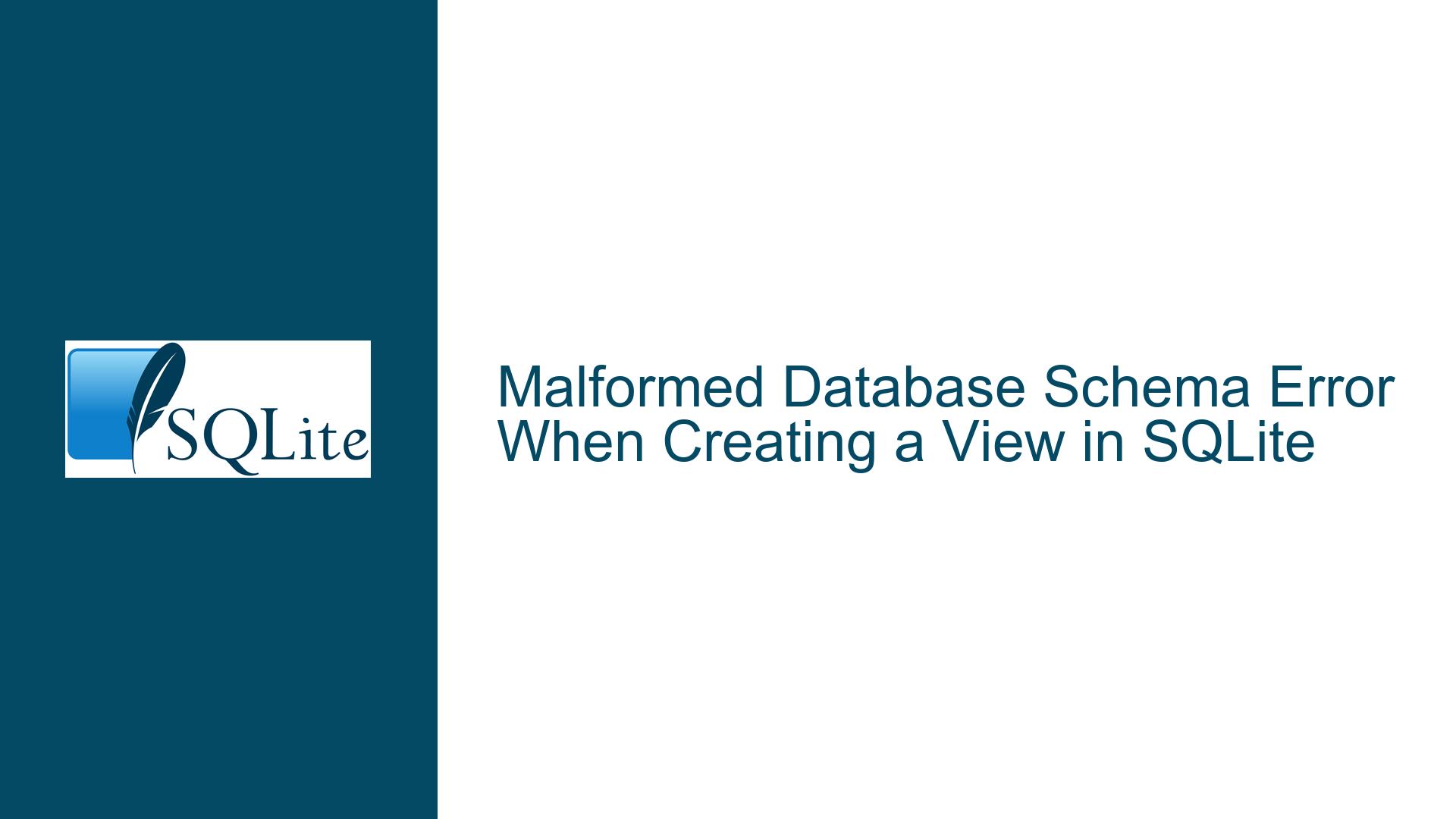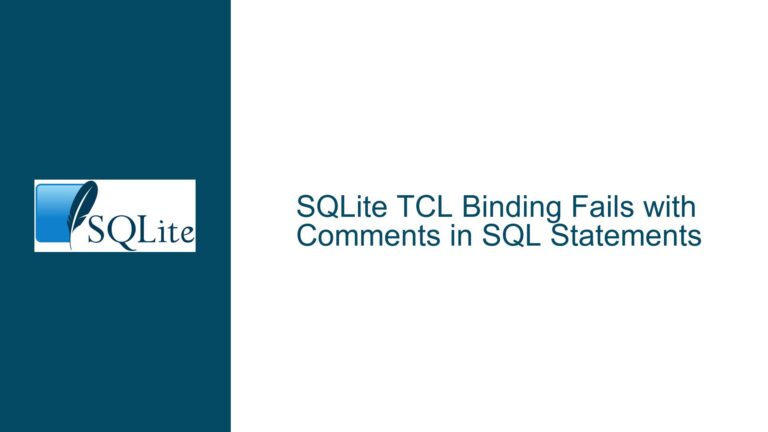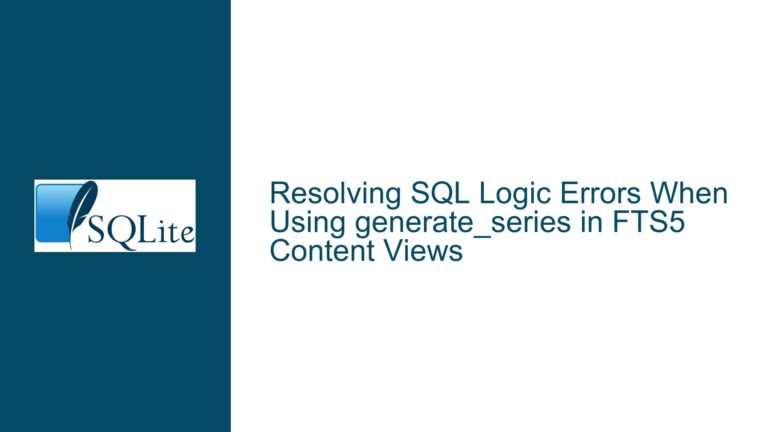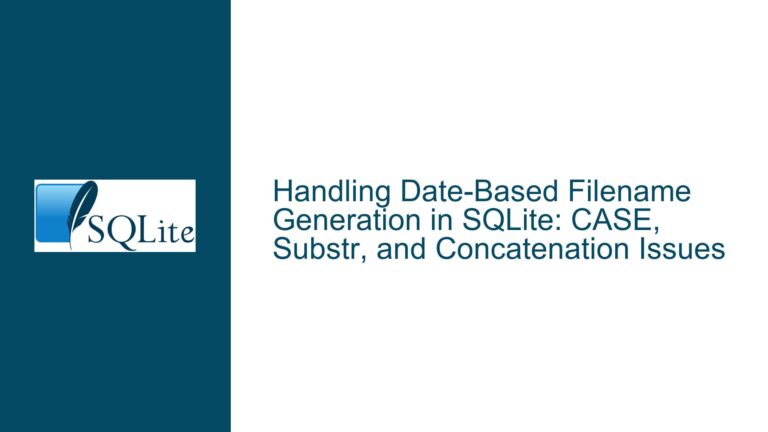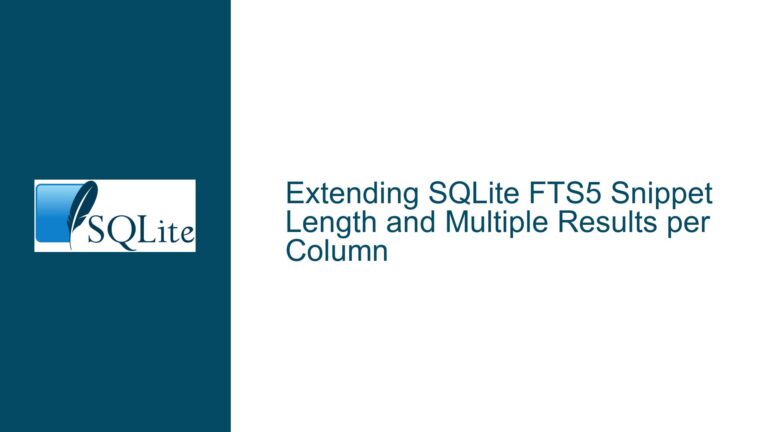Malformed Database Schema Error When Creating a View in SQLite
Issue Overview: Malformed Database Schema Error After View Creation
The core issue revolves around a malformed database schema error that occurs after creating a view in SQLite. The error message specifically states: "malformed database schema (Brenner Starts and Stops) – near ‘(‘: syntax error." This error is encountered when attempting to insert data into the Temperaturen table using a PowerShell command after the view Brenner Starts and Stops has been created. The view itself appears to function correctly when queried, but the presence of the view causes the insertion operation to fail with the aforementioned error.
The view Brenner Starts and Stops is designed to aggregate data from the Brenner table, counting the number of times the Brenner column has the values ‘EIN’ and ‘AUS’ for each day. The view uses the FILTER clause, which is a relatively recent addition to SQLite, to perform conditional aggregation. The error does not occur when the view is deleted, suggesting that the view’s creation is somehow interfering with the database’s schema integrity or the insertion operation.
The user is using SQLite version 3.44.2, but it is later revealed that the invoke-SqliteQuery command in PowerShell is actually using an older version of SQLite (3.8.8.3) through the System.Data.SQLite library. This discrepancy in SQLite versions is a critical factor in understanding the root cause of the issue.
Possible Causes: Version Mismatch and Syntax Incompatibility
The primary cause of the malformed database schema error is the version mismatch between the SQLite CLI (Command Line Interface) and the SQLite library used by the invoke-SqliteQuery command in PowerShell. The user initially believed they were using SQLite version 3.44.2, but the invoke-SqliteQuery command is actually using version 3.8.8.3. This older version of SQLite does not support the FILTER clause, which was introduced in SQLite version 3.30.0. As a result, when the view is created using the FILTER clause, the older version of SQLite cannot parse the syntax correctly, leading to the malformed schema error.
Another potential cause is the use of single quotes for identifiers (e.g., table and column names) instead of double quotes. While this is not directly related to the malformed schema error, it is a best practice to use double quotes for identifiers and single quotes for string literals in SQLite. This ensures that the SQL statements are unambiguous and reduces the risk of syntax errors.
Additionally, the error could be related to the way the view is constructed. The view uses the FILTER clause in conjunction with the COUNT function to perform conditional aggregation. If the FILTER clause is not supported by the SQLite version being used, the view creation statement would fail, leading to a malformed schema. The error message indicates a syntax error near the opening parenthesis, which suggests that the SQLite parser is unable to interpret the FILTER clause correctly.
Troubleshooting Steps, Solutions & Fixes: Resolving Version Mismatch and Syntax Issues
To resolve the malformed database schema error, the following steps should be taken:
Verify the SQLite Version Used by
invoke-SqliteQuery:
The first step is to confirm the version of SQLite being used by theinvoke-SqliteQuerycommand. This can be done by running the following PowerShell command:invoke-SqliteQuery -DataSource $DataSource -Query "select sqlite_version();"If the version returned is older than 3.30.0, it means that the
FILTERclause is not supported, and the view creation statement will fail.Upgrade the SQLite Library Used by
invoke-SqliteQuery:
If the version of SQLite used byinvoke-SqliteQueryis outdated, the next step is to upgrade the SQLite library. This can be done by updating the System.Data.SQLite library to a version that includes SQLite 3.30.0 or later. Alternatively, the user can switch to using the SQLite CLI directly from PowerShell, ensuring that the correct version of SQLite is being used.Modify the View Creation Statement:
If upgrading the SQLite library is not feasible, the view creation statement can be modified to avoid using theFILTERclause. Instead, conditional aggregation can be achieved using theCASEstatement, which is supported by older versions of SQLite. The modified view creation statement would look like this:CREATE VIEW "Brenner Starts and Stops" AS SELECT substr(Datum,1,10) AS Tag, COUNT(CASE WHEN Brenner = 'EIN' THEN 1 END) AS "Brenner Starts", COUNT(CASE WHEN Brenner = 'AUS' THEN 1 END) AS "Brenner Stops" FROM Brenner GROUP BY substr(Datum,1,10) ORDER BY Datum DESC;This approach achieves the same result as the original view but uses syntax that is compatible with older versions of SQLite.
Run an Integrity Check on the Database:
After making the necessary changes, it is important to run an integrity check on the database to ensure that the schema is not corrupted. This can be done using the following SQLite command:PRAGMA integrity_check;If the integrity check returns "ok," it means that the database schema is intact and the issue has been resolved.
Test the Insertion Operation:
Finally, test the insertion operation into theTemperaturentable to ensure that the error no longer occurs. The PowerShell command for inserting data should now work without any issues:$SQL = "Insert into 'Temperaturen' (Datum, Zeit, VLHK, RLHK, VL, RL, VLSolar, Speicher, Brenner, SP, UP, WW, Zirku, ZP) Values ('$Datum','$Zeit','$VLHK','$RLHK','$VL','$RL','$VLSolar','$Speicher','$Brenner','$SP','$Up','$WW','$Zirku','$ZP');" invoke-SqliteQuery -DataSource $DataSource -Query $SQL -QueryTimeout 3
By following these steps, the malformed database schema error should be resolved, and the view Brenner Starts and Stops should function correctly without interfering with the insertion operation. It is also important to ensure that the correct version of SQLite is being used to avoid similar issues in the future.
